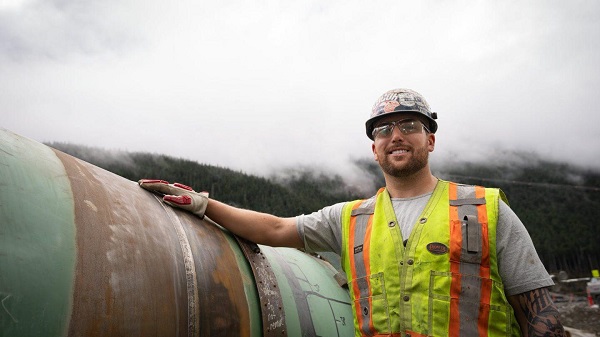Canadian Energy Centre
New compressed natural gas project to bring energy security to Canada’s north

Aerial view of the Hamlet of Tuktoyaktuk on the shores of the Beaufort Sea in the Canadian Arctic. Getty Images photo
From the Canadian Energy Centre
By Cody Ciona
‘The whole project is for the purpose of addressing the energy security issue that many northerners face’
The recent approval of the first compressed natural gas facility in the Northwest Territories is bringing energy security one step closer to remote and Indigenous communities in Canada’s north.
The Inuvialuit Energy Security Project (IESP), owned by the Inuvialuit Regional Corp. , will be located 16 kilometres south of Tuktoyaktuk. The project, recently approved by the Canadian Energy Regulator, will convert natural gas into compressed natural gas (CNG), propane, and diesel for the Inuvialuit Settlement region.
“The whole project is for the purpose of addressing the energy security issue that many northerners face, but particularly northerners that are at the end of a very long road,” said Inuvialuit Petroleum Corporation special advisor Kate Darling.
The natural gas will be supplied by the Tuk M-18 well, which is also owned by the Inuvialuit, and transported to local customers for power, heat, and fuel.
Currently, the region is serviced by the Inuvik Gas Project (natural gas from two wells at the Ikhil reservoir, 50 kilometres northwest of Inuvik), and by truck from the south in B.C. The Ikhil wells’ reserves are now critically low, which led to the push for the IESP. The Tuk M-18, however, is estimated to have more than 100 years’ worth of reserves.
About 200,000 people in Canada have no connection to an energy grid or natural gas distribution systems. This includes nearly 100,000 people in the northern territories.
In the Northwest Territories, refined petroleum products like diesel make up 74 per cent of end-use demand, brought in by trucks. In Inuvialuit’s case, that’s a 5,000-kilometre round trip including a ferry ride. In the past, Inuvialuit has faced potential operation disruption of the ferry service, which put the community in an emergency fuel situation.
“[The IESP] could provide long-term energy to the communities in the region, as well as reducing greenhouse gas emissions, creating long-term employment,” said Duane Ningaqsiq Smith, chair of the Inuvialuit Regional Corporation.
“It represents an Inuvialuit-led solution that takes into account the preservation of our values, advances participation in the northern and national economy, all while reducing emissions and helping preserve our local environment.”
In addition to providing energy security for remote communities, the IESP will have a significant positive impact on emissions reduction. It is estimated it will have a net reduction of around 40,000 tonnes of emissions per year, equivalent to the yearly emissions of 9,520 cars.
The project is also expected to support 25 full-time jobs and a further 35 full-time jobs within the local community.
“All in all … the M-18 will really help not just the surrounding communities of Tuk, but create a lot of jobs for locals, which is very good,” said Ryan Yakeleya, a Tuktoyaktuk councillor.
The IESP has already injected over $20 million into local businesses with over 70 Inuvialuit and Gwich’in peoples employed to date, according to the latest project update.
“IPC is committed to developing the IESP and ensuring that as much of the economic benefit and employment opportunities are offered to Inuvialuit,” said Duane Ningaqsiq Smith, IRC Chair and CEO.
The project is expected to begin producing and delivering gas to consumers by the end of 2025.
2025 Federal Election
Canada’s pipeline builders ready to get to work

From the Canadian Energy Centre
“We’re focusing on the opportunity that Canada has, perhaps even the obligation”
It was not a call he wanted to make.
In October 2017, Kevin O’Donnell, then chief financial officer of Nisku, Alta.-based Banister Pipelines, got final word that the $16-billion Energy East pipeline was cancelled.
It was his job to pass the news down the line to reach workers who were already in the field.
“We had a crew that was working along the current TC Energy line that was ready for conversion up in Thunder Bay,” said O’Donnell, who is now executive director of the Mississauga, Ont.-based Pipe Line Contractors Association of Canada (PLCAC).
“I took the call, and they said abandon right now. Button up and abandon right now.
“It was truly surreal. It’s tough to tell your foreman, who then tells their lead hands and then you inform the unions that those three or four or five million man-hours that you expected are not going to come to fruition,” he said.

Workers guide a piece of pipe along the Trans Mountain expansion route. Photograph courtesy Trans Mountain Corporation
“They’ve got to find lesser-paying jobs where they’re not honing their craft in the pipeline sector. You’re not making the money; you’re not getting the health and dental coverage that you were getting before.”
O’Donnell estimates that PLCAC represents about 500,000 workers across Canada through the unions it works with.
With the recent completion of the Trans Mountain expansion and Coastal GasLink pipelines – and no big projects like them coming on the books – many are once again out of a job, he said.
It’s frustrating given that this could be what he called a “golden age” for building major energy infrastructure in Canada.
Together, more than 62,000 people were hired to build the Trans Mountain expansion and Coastal GasLink projects, according to company reports.
O’Donnell is particularly interested in a project like Energy East, which would link oil produced in Alberta to consumers in Eastern and Atlantic Canada, then international markets in the offshore beyond.
“I think Energy East or something similar has to happen for millions of reasons,” he said.
“The world’s demanding it. We’ve got the craft [workers], we’ve got the iron ore and we’ve got the steel. We’re talking about a nation where the workers in every province could benefit. They’re ready to build it.”

The “Golden Weld” marked mechanical completion of construction of the Trans Mountain Expansion Project on April 11, 2024. Photo courtesy Trans Mountain Corporation
That eagerness is shared by the Progressive Contractors Association of Canada (PCA), which represents about 170 construction and maintenance employers across the country.
The PCA’s newly launched “Let’s Get Building” advocacy campaign urges all parties in the Canadian federal election run to focus on getting major projects built.
“We’re focusing on the opportunity that Canada has, perhaps even the obligation,” said PCA chief executive Paul de Jong.
“Most of the companies are quite busy irrespective of the pipeline issue right now. But looking at the long term, there’s predictability and long-term strategy that they see missing.”
Top of mind is Ottawa’s Impact Assessment Act (IAA), he said, the federal law that assesses major national projects like pipelines and highways.
In 2023, the Supreme Court of Canada found that the IAA broke the rules of the Canadian constitution.
The court found unconstitutional components including federal overreach into the decision of whether a project requires an impact assessment and whether a project gets final approval to proceed.
Ottawa amended the act in the spring of 2024, but Alberta’s government found the changes didn’t fix the issues and in November launched a new legal challenge against it.
“We’d like to see the next federal administration substantially revisit the Impact Assessment Act,” de Jong said.
“The sooner these nation-building projects get underway, the sooner Canadians reap the rewards through new trading partnerships, good jobs and a more stable economy.”
Canadian Energy Centre
First Nations in Manitoba pushing for LNG exports from Hudson’s Bay

From the Canadian Energy Centre
By Will Gibson
NeeStaNan project would use port location selected by Canadian government more than 100 years ago
Building a port on Hudson’s Bay to ship natural resources harvested across Western Canada to the world has been a long-held dream of Canadian politicians, starting with Sir Wilfred Laurier.
Since 1931, a small deepwater port has operated at Churchill, Manitoba, primarily shipping grain but more recently expanding handling of critical minerals and fertilizers.
A group of 11 First Nations in Manitoba plans to build an additional industrial terminal nearby at Port Nelson to ship liquefied natural gas (LNG) to Europe and potash to Brazil.
Robyn Lore, a director with project backer NeeStaNan, which is Cree for “all of us,” said it makes more sense to ship Canadian LNG to Europe from an Arctic port than it does to send Canadian natural gas all the way to the U.S. Gulf Coast to be exported as LNG to the same place – which is happening today.
“There is absolutely a business case for sending our LNG directly to European markets rather than sending our natural gas down to the Gulf Coast and having them liquefy it and ship it over,” Lore said. “It’s in Canada’s interest to do this.”
Over 100 years ago, the Port Nelson location at the south end of Hudson’s Bay on the Nelson River was the first to be considered for a Canadian Arctic port.
In 1912, a Port Nelson project was selected to proceed rather than a port at Churchill, about 280 kilometres north.
The Port Nelson site was earmarked by federal government engineers as the most cost-effective location for a terminal to ship Canadian resources overseas.
Construction started but was marred by building challenges due to violent winter storms that beached supply ships and badly damaged the dredge used to deepen the waters around the port.
By 1918, the project was abandoned.
In the 1920s, Prime Minister William Lyon MacKenzie King chose Churchill as the new location for a port on Hudson’s Bay, where it was built and continues to operate today between late July and early November when it is not iced in.
Lore sees using modern technology at Port Nelson including dredging or extending a floating wharf to overcome the challenges that stopped the project from proceeding more than a century ago.
He said natural gas could travel to the terminal through a 1,000-kilometre spur line off TC Energy’s Canadian Mainline by using Manitoba Hydro’s existing right of way.
A second option proposes shipping natural gas through Pembina Pipeline’s Alliance system to Regina, where it could be liquefied and shipped by rail to Port Nelson.
The original rail bed to Port Nelson still exists, and about 150 kilometers of track would have to be laid to reach the proposed site, Lore said.
“Our vision is for a rail line that can handle 150-car trains with loads of 120 tonnes per car running at 80 kilometers per hour. That’s doable on the line from Amery to Port Nelson. It makes the economics work for shippers,” said Lore.
Port Nelson could be used around the year because saltwater ice is easier to break through using modern icebreakers than freshwater ice that impacts Churchill between November and May.
Lore, however, is quick to quell the notion NeeStaNan is competing against the existing port.
“We want our project to proceed on its merits and collaborate with other ports for greater efficiency,” he said.
“It makes sense for Manitoba, and it makes sense for Canada, even more than it did for Laurier more than 100 years ago.”
-

 Alberta2 days ago
Alberta2 days agoGovernments in Alberta should spur homebuilding amid population explosion
-

 International2 days ago
International2 days agoHistory in the making? Trump, Zelensky hold meeting about Ukraine war in Vatican ahead of Francis’ funeral
-

 Alberta2 days ago
Alberta2 days agoLow oil prices could have big consequences for Alberta’s finances
-

 Business2 days ago
Business2 days agoIt Took Trump To Get Canada Serious About Free Trade With Itself
-

 2025 Federal Election2 days ago
2025 Federal Election2 days agoCarney’s budget is worse than Trudeau’s
-

 C2C Journal1 day ago
C2C Journal1 day ago“Freedom of Expression Should Win Every Time”: In Conversation with Freedom Convoy Trial Lawyer Lawrence Greenspon
-

 Opinion1 day ago
Opinion1 day agoCanadians Must Turn Out in Historic Numbers—Following Taiwan’s Example to Defeat PRC Election Interference
-

 2025 Federal Election17 hours ago
2025 Federal Election17 hours agoColumnist warns Carney Liberals will consider a home equity tax on primary residences









